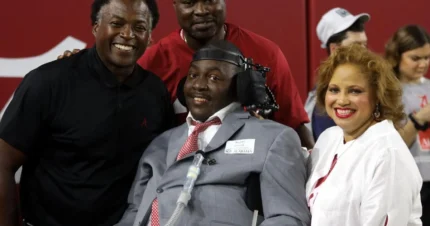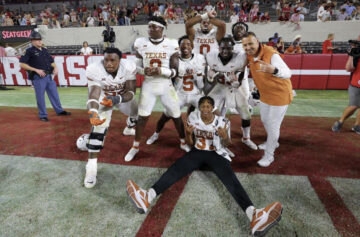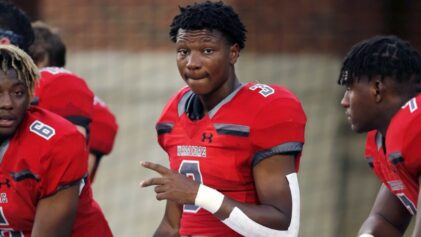Alabama has won 18 national titles and seven since Nick Saban assumed the helm in 2007.
‘Bama has been the flagship college football program, producing NFL stars, defensive legends and in recent years elite, first-round quarterbacks.
Saban has sent 96 players to the NFL since he arrived in Tuscaloosa, and according to fansided.com, more than half of those players were drafted in the first two rounds.
Alabama’s struggle to defeat a game Florida squad on Saturday was more than an off game for the most talented program in the country.
Some college football analysts see it as an omen of things to come this season for an Alabama squad that was expected to once again roll through the SEC and into the CFB Playoff National Championship.
Three days in Alabama to learn why the state now dominates college football. In four words: "It is damn important." http://t.co/UuVYohPkyy
— Pat Forde (@ByPatForde) December 30, 2014
The Tide isn’t the only powerhouse squad looking vulnerable.
Closing The Gap
Clemson’s the second-most dominant team after Alabama over the last half decade. The Tigers are 2-2 after losing to unranked N.C. State in overtime on Saturday.
The Ohio State Buckeyes lost at home to an underrated Oregon, but they also labored in getting by the Golden Gophers of Minnesota (which lost to Bowling Green on Saturday) and Tulsa two weeks ago.
Oklahoma is 4-0 but barely escaped Tulane — which was displaced following Hurricane Ida — Nebraska, and West Virginia in a game the Sooners didn’t lead until the final gun.
Let’s not read too much into Alabama’s 31-29 close call on Sept. 18, but you can’t ignore the way their five-star defense was gored for 440 yards, 145 of them on the ground.
Could it be parity? Is this a direct result of the transfer portal that saw COVID-19 lead to loosened transfer rules?
It’s still September, so it might be too early to draw any concrete conclusions, but the universities once considered the top dawgs seems to have lost some of their hefty advantage over the rest of the country.
Effects Of COVID Mass Transfer Portal
According to si.com, “there were over 2,500 football players who decided to enter the portal since their last season ended, and some — most, definitely — weren’t pursued by Alabama or Georgia or Clemson or Ohio State.”
That means some programs who were on the fringe of breaking through got better — and quickly.
To see the top programs of the CFP era look so shaky this early is actually stunning. To have it happen prior to conference play is even more of a shock.
The changing landscape of college football — from the easing of transfer and redshirt rules to the NIL deals allowing players to market their name and likeness to the NCAA saying the 2020 season in essence didn’t count against an athlete’s eligibility — are all just part of the new era of college sports.
Blue chip college athletes don’t have to go to the Top 5 power schools in order to set themselves up for exposure and a huge payday in the pros anymore. These players can chase playing time rather than a specific program.
NIL rules a POSITIVE for parity in College Football? pic.twitter.com/mQ3a3G4Ggn
— PFF College (@PFF_College) July 1, 2021
Many of the top players choosing to attend Power Schools are now entering those universities with thousands of dollars in marketing deals already in tow. It’s a good thing that these athletes can get paid, but their ability to make money definitely minimizes the importance of playing the sport at a specific school.
Must Be The Money
Clemson quarterback D.J. Uiagalelei is terribly underperforming this season (No.112 in FBS in passing efficiency) but that hasn’t knocked his hustle. He has his own Dr. Pepper commercial.
Spencer Rattler has been better than Uiagalelei, but not by much. The preseason Heisman favorite and Oklahoma quarterback signed with celebrity agent Leigh Steinberg’s company.
He has a personal logo, will record a greeting or voicemail for a fee, has an endorsement deal with a fast-food chicken restaurant chain, and even signed autographs this summer for $150 a pop at a memorabilia convention.
Olivia Dunne and Spencer Rattler headline plant-based wellness company PlantFuel's first group of NIL athletes 🌱
Each athlete is receiving cash and product. Dunne is also getting stock options, per @Forbes. pic.twitter.com/LHz6HQqbPk
— Front Office Sports (@FOS) September 23, 2021
The former No. 1 player in the class of 2022 was Ohio State QB Quinn Ewers, who’s from Texas, a state that prohibits athletes from profiting from their name, image and likeness. So Ewers skipped his senior season of high school ball and reclassified to the class of 2021 to enroll at OSU.
COMMITTED!! #Godsplan pic.twitter.com/7bLQrU8hAz
— Quinn Ewers (@QuinnEwers) November 20, 2020
The Game Done Changed
Point blank, kids wanna play, get famous, and get paid sooner than later.
The biggest stars in the sport are still the coaches, and that isn’t changing. But maybe many of these rich men with huge egos who oppose the transfer portal and NIL will begin to loosen their grip a little and realize that the student-athlete has more choices than ever.
There are more kids playing and there’s more talent to go around. One huge recruiting class or bringing in a few game-changing transfers can disrupt the balance of college football and bring about the parity that we are seeing early in the CFB season.



